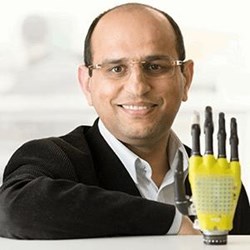Graphene Harvests Solar Energy To Power 'Electronic Skin'
By Jof Enriquez,
Follow me on Twitter @jofenriq

University of Glasgow researchers have developed a layer of graphene that can harvest sunlight to power 'electronic skin,' whose development holds much promise in the fields of prosthetics and robotics.
Dr. Ravinder Dahiya, director of the university's Electronics Systems Design Centre (ESDC), and his colleagues from the Bendable Electronics and Sensing Technologies (BEST) group have made significant strides in developing advanced prosthetic limbs that integrate synthetic skin capable of making sensitive pressure measurements to help amputees grip soft objects easily.
The team’s latest research delved into finding an independent, ultra-low-power source to enable this tactile skin to provide precise haptic feedback for longer periods of time. The wonder material graphene provided a viable solution, as it is known to be highly flexible, electrically conductive, and transparent — it lets up to 98 percent of light to pass through. Graphene's transparency is considered a key characteristic to allow photovoltaics cells to effectively harvest light.
In a recent edition of the journal Advanced Function Materials, Dahiya and co-study authors described building "a novel structure, consisting of a transparent tactile sensitive layer based on single-layer graphene, and a photovoltaic cell underneath as a building block for energy-autonomous, flexible, and tactile skin."
The electronic skin requires just 20 nanowatts of power per square centimeter, which can be delivered even by the lowest-quality photovoltaic cells on the market, according to a news release.
"Moreover, ultralow power consumed by the sensitive layer (20 nW cm−2) further reduces the photovoltaic area required to drive the tactile skin," the authors wrote in the journal paper. "In addition to its energy autonomy, the fabricated skin is sensitive to touch, mainly because a transparent polymeric protective layer, spin-coated on the sensor's active area, makes the coplanar capacitor sensitive to touch, detecting minimum pressures of 0.11 kPa with a uniform sensitivity of 4.3 Pa−1 along a broad pressure range."
Dahiya said the researchers want to further develop their electronic skin and its solar power harvesting method to power the motors of the prosthetic hand itself. These technologies could potentially be applied to wearable devices that monitor health, as well.
The University of Glasgow research group received funding support from the Scottish Funding Council and the Engineering and Physical Sciences Research Council (EPSRC).
